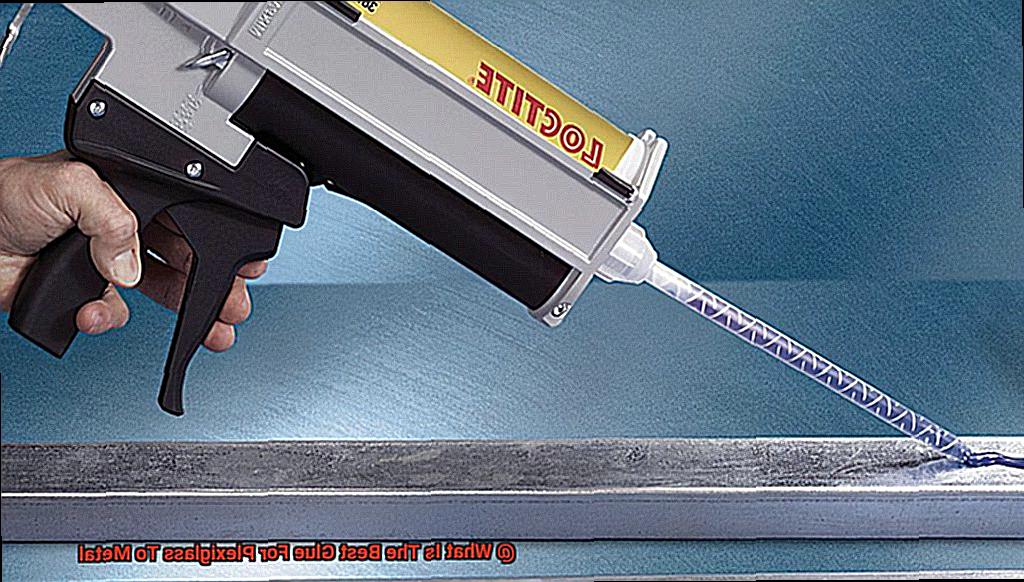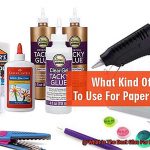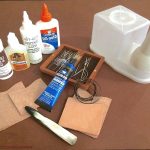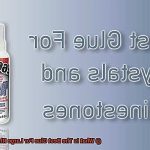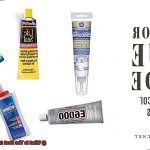Are you on the hunt for the ultimate adhesive to unite plexiglass and metal?
When it comes to joining these two materials, finding the perfect glue is an absolute must.
With so many options available, it’s crucial to choose a glue specifically crafted for this purpose to guarantee a bond that’s as strong as steel. In this blog post, we’ll explore the top contenders vying for the title of best glue for plexiglass to metal.
So, let’s dive right in and uncover the adhesive that will seamlessly connect your plexiglass and metal surfaces with unwavering strength.
Adhesives for Bonding Plexiglass to Metal
Contents
- 1 Adhesives for Bonding Plexiglass to Metal
- 2 Pros and Cons of Epoxy
- 3 Pros and Cons of Cyanoacrylate Glue (Super Glue)
- 4 Pros and Cons of Silicone Adhesive
- 5 Specialized Adhesives for Bonding Plexiglass to Metal
- 6 Factors to Consider When Choosing an Adhesive
- 7 Preparing the Surfaces for Bonding
- 8 Mechanical Fasteners for Added Strength
- 9 Conclusion
Selecting the appropriate adhesive is crucial when bonding plexiglass to metal. With various options available, it is essential to understand the different adhesives and their suitability for this specific application. In this article, we will explore popular adhesives and considerations to make when selecting one.
Epoxy Adhesives:
Epoxy adhesives offer exceptional bonding strength and versatility. Comprising two components – resin and hardener – they must be mixed before application. Once cured, epoxy creates a robust bond that can endure temperature fluctuations and moisture exposure. It is ideal for bonding plexiglass to metal in a range of applications.
Cyanoacrylate Adhesives (Super Glue):
Cyanoacrylate adhesives, commonly known as super glue, dry quickly and provide an instant bond. They work effectively on porous and non-porous surfaces, including plexiglass and metal. However, it is crucial to choose a specific formulation designed for bonding plexiglass to ensure optimal adhesion.
Silicone Adhesives:
For outdoor or high-temperature environments, silicone adhesives are suitable. They resist weathering, UV rays, and extreme temperatures. Silicone adhesives also offer flexibility to accommodate expansion or contraction between plexiglass and metal due to temperature changes.
Acrylic-Based Adhesives:
Acrylic-based adhesives are specifically formulated for bonding acrylic materials like plexiglass. They provide a strong and durable bond but may require surface preparation or primers for optimal adhesion.
Considerations for Selection:
When choosing an adhesive for bonding plexiglass to metal, consider application requirements (indoor vs. outdoor), desired bond strength, surface conditions of the materials being bonded, and any specific environmental factors that may affect bond durability. Follow the manufacturer’s instructions and perform a small test before applying the adhesive to the entire project.
Pros and Cons of Epoxy
When it comes to joining plexiglass and metal, epoxy emerges as a strong and durable adhesive partner. However, like any partnership, epoxy comes with its own set of pros and cons. So, let’s take a closer look at the advantages and disadvantages of using epoxy for bonding plexiglass to metal.
Pros:
- Impressive Bonding Strength: Epoxy brings muscle to the table with its exceptional bonding strength. It forms a secure connection between plexiglass and metal surfaces, ensuring a long-lasting and reliable bond. Whether you’re dealing with heavy or load-bearing applications, epoxy has got your back.
- Versatility Personified: Epoxy is a versatile adhesive that can stick to various materials, including different types of metals and plexiglass. Whether you’re working with stainless steel, aluminum, or acrylic, epoxy can provide a reliable bond. Its versatility makes it suitable for a wide range of applications.
- Temperature and Chemical Resistance: Epoxy can handle the heat. It withstands high temperatures without losing its adhesive properties or becoming brittle. This makes it perfect for projects exposed to extreme weather conditions or high-temperature environments. And don’t worry about chemicals – epoxy is resistant to many solvents and acids, making it a durable choice.
Cons:
- Curing Time: If you’re in a rush, epoxy might make you tap your toes impatiently. It requires sufficient curing time to reach its maximum strength, which means waiting hours or even days. So if you’re on a tight schedule, epoxy’s curing time may be a drawback.
- Tricky Mixing Process: Epoxy is a two-component adhesive that requires precise mixing of resin and hardener in specific proportions. If you don’t get the ratio right, the bond may not cure properly or develop weak spots. So, grab your measuring cups and pay attention to avoid any mishaps.
- Messy Business: Epoxy has a thick consistency, which can lead to drips and smears during application. This can result in an unwanted mess that requires extra cleanup efforts. And once epoxy has cured, it’s not easy to undo or reposition the materials if you make a mistake.
- Aesthetic Concerns: While epoxy offers excellent bonding strength, it may not be the most visually appealing option. The adhesive can create visible lines or marks between the plexiglass and metal surfaces, which might be a drawback for applications where appearance matters.
Pros and Cons of Cyanoacrylate Glue (Super Glue)
Super glue, also known as cyanoacrylate glue, is a popular choice for bonding plexiglass to metal due to its fast-acting and strong adhesive properties. Let’s take a closer look at the advantages and disadvantages of using this type of glue for this specific application.
Advantages:
- Quick drying time: One of the main advantages of cyanoacrylate glue is its rapid drying time. It sets within seconds, allowing for immediate handling and reducing the need for clamping or applying pressure during the bonding process.
- High bond strength: Super glue forms a strong and durable bond between plexiglass and metal surfaces, ensuring a long-lasting and reliable connection. This is especially important when bonding materials that may be subjected to stress or impact.
- Versatility: Cyanoacrylate glue is known for its versatility as it can be used on various materials, including plexiglass and different types of metals like aluminum or stainless steel. This makes it a convenient option for bonding different substrates together.
- Resistance to moisture and chemicals: While not completely waterproof or impervious to chemical exposure, super glue offers some resistance to moisture and chemicals. It can withstand moderate levels of these factors without compromising the bond.
- Ease of use: Super glue is easy to use as it typically comes in small tubes or bottles with precision applicators. This allows for accurate and controlled application, making it suitable for both small-scale projects and larger applications.
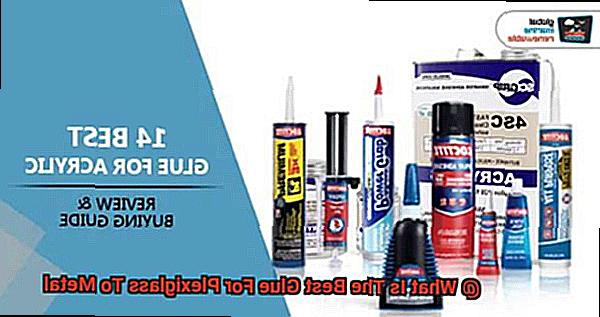
Disadvantages:
- Brittleness: One potential drawback of cyanoacrylate glue is its brittleness once dried. It tends to dry hard and rigid, which can make it prone to cracking or breaking under stress or impact.
- Difficulty in removal: If excess glue spills or if repositioning is required after bonding, removing super glue can be challenging without causing damage to the surfaces.
- Limited gap-filling capabilities: Cyanoacrylate glue works best on clean, well-fitting surfaces with minimal gaps or unevenness. If there are significant gaps between the plexiglass and metal, additional fillers or adhesives may be necessary for a secure bond.
- Sensitivity to temperature and humidity: Extreme temperatures or high levels of moisture can affect the performance and bonding strength of cyanoacrylate glue. It is important to consider these factors when using super glue for plexiglass to metal applications.
Pros and Cons of Silicone Adhesive
Silicone adhesive, the perfect adhesive for bonding plexiglass to metal, has a range of advantages that make it an excellent choice for this specific application. However, it’s essential to weigh the pros against the cons to determine if it’s the right fit for your project.
Let’s start with the pros. First and foremost, silicone adhesive is incredibly versatile. It can bond a wide range of materials, including plexiglass and metal, making it suitable for various applications. Whether you’re sealing, bonding, or creating a gasket, silicone adhesive has got you covered.
Temperature resistance is another significant advantage. Silicone adhesive can withstand extreme heat and cold without losing its adhesive properties or breaking down. So, if your project involves temperature fluctuations, rest assured that silicone adhesive can handle it like a champ.

Flexibility is a crucial trait of silicone adhesive. It can withstand movement or vibration without cracking or losing its bond. This feature is especially beneficial when bonding materials with different coefficients of expansion because silicone adhesive can accommodate those changes without compromising its bond.
Silicone adhesive is also inherently waterproof and moisture-resistant, making it perfect for sealing or bonding in wet or humid environments. It forms a reliable barrier against water, preventing any leaks or damage caused by moisture.
Lastly, this adhesive exhibits excellent resistance to chemicals, making it suitable for use in various industries where exposure to harsh chemicals is common.
Now, let’s explore the cons. Silicone adhesive typically has a longer cure time compared to other adhesives. It may take several hours or even days to fully cure and develop its maximum strength. So if you’re in a hurry for quick bonding, you may need to consider alternative options.
Initial tack might be lower with silicone adhesive compared to other adhesives. This means that it may take some time for the bond to develop its full strength. If immediate strength is crucial for your application, you may need to factor this into your decision-making process.
Proper surface preparation is essential when using silicone adhesive. The surfaces need to be clean, dry, and free from any contaminants or residues. Any presence of oils, dust, or moisture can affect the adhesive’s performance.
While silicone adhesive offers good adhesion to various materials, it may not provide the same level of bond strength as other types of adhesives like epoxy or cyanoacrylate. If your project requires extremely high bond strength, you might need to explore other options.
Lastly, cost can be a deterrent for some users. Silicone adhesive tends to be more expensive compared to other adhesives on the market. If you’re working on a large-scale project or anticipate frequent use, you might need to consider the cost implications.
Specialized Adhesives for Bonding Plexiglass to Metal
In this comprehensive guide, we’ll explore the world of specialized adhesives that are perfect for this task. Let’s dive in and discover the glue that will bring your projects to life.
Epoxy Adhesives:
Epoxy adhesives are the superheroes of bonding plexiglass to metal. With exceptional strength and the ability to bond different materials, they are perfect for heavy-duty applications. These adhesives consist of a resin and a hardener that need to be mixed before application. They offer excellent resistance to water, chemicals, and heat.
Cyanoacrylate Adhesives:
For smaller bonding applications, cyanoacrylate adhesives, also known as super glue or instant glue, come to the rescue. They provide fast curing and strong bonds by reacting with moisture in the air. Remember to clean and dry the surfaces before application for optimal results.
Acrylic Cement:
Specifically designed for bonding plexiglass or acrylic, acrylic cement works wonders when bonding plexiglass to metal. It softens the surfaces of the plexiglass and creates a chemical bond as it evaporates. Handle it with care though, as excessive application can damage the plexiglass.
Silicone Adhesives:
Silicone adhesives are the flexible warriors that excel at bonding plexiglass to metal, even on uneven surfaces. They offer good adhesion while being resistant to temperature changes, moisture, and UV radiation. Just make sure you have proper ventilation during the curing process.
Considerations:
When choosing your adhesive, keep in mind factors such as the application, size and weight of the materials being bonded, and environmental conditions. It’s always a good idea to perform a test bond before diving into your project.
Mechanical Fasteners:
If you seek additional strength and stability, consider using mechanical fasteners like screws or rivets. They can be great companions for load-bearing structures, but keep in mind that they might require drilling and modifications to your materials.
Factors to Consider When Choosing an Adhesive
Get ready to embark on a project that involves bonding plexiglass to metal. The key to success? Choosing the perfect adhesive. In this article, we’ll explore the factors you need to consider when selecting an adhesive for this specific application. So, gear up and let’s become glue superheroes.
Factor 1: Material Compatibility:
Consider the materials at hand. Plexiglass is a lightweight, transparent thermoplastic, while metal can range from aluminum to steel or copper. Find an adhesive that is compatible with both materials. Different adhesives are designed for specific types of metal, so choose one that creates a strong bond between plexiglass and your chosen metal.
Factor 2: Surface Preparation:
Before applying the adhesive, prepare the surfaces properly. Cleanliness is key – remove dust, dirt, and grease from both the plexiglass and metal surfaces. Follow the adhesive manufacturer’s cleaning recommendations. In some cases, you may need to roughen or etch the surfaces for better adhesion. Remember, a clean surface ensures optimal bond strength.
Factor 3: Application Method:
Now it’s time to apply the adhesive. Consider the size, shape, and precision required for your project. Some adhesives come in liquid form and can be brushed or applied using a nozzle. Others come as tapes or films. Choose an application method that suits your needs and allows for even distribution of the adhesive on both surfaces.
Factor 4: Environmental Conditions:
Think about where your bonded materials will end up. Will they face temperature fluctuations, high humidity levels, UV radiation, or chemical exposure? Different adhesives have varying resistance to environmental conditions. Choose an adhesive that can withstand the specific challenges your project will encounter. This ensures long-term durability and prevents any unwanted surprises down the road.
Preparing the Surfaces for Bonding
Preparing the surfaces for bonding is a critical step in the process of gluing plexiglass to metal. It may not sound like the most exciting topic, but trust me, it’s the secret to achieving a bond that is strong and long-lasting. So let’s dive into the fascinating world of surface preparation.
First and foremost, let’s talk about cleaning. Just as you wouldn’t want to stick a sticker on a dirty window, you don’t want to bond plexiglass to metal with dirty surfaces. So grab some mild detergent and water and give those surfaces a thorough wipe down. This will eliminate any dirt or grease that could interfere with the adhesion process. After rinsing them off, make sure they’re bone dry before moving on to the next step.
Now let’s roughen things up a bit. Imagine creating a rough surface for the glue to grip onto, like tiny hooks locking everything in place. You can achieve this by using sandpaper or a sanding block with medium grit to create tiny scratches or grooves on both the plexiglass and metal surfaces. Remember, evenness and consistency are key for maximum bond strength.
After all that sanding, it’s crucial to wipe away any debris that may have been left behind. A clean surface is essential for a successful bond, so grab a clean cloth and give those surfaces one final wipe down.
Now here’s a little secret weapon you might want to consider – a primer or adhesion promoter. These bad boys are specifically designed to improve adhesion between different materials, like plexiglass and metal. Just follow the manufacturer’s instructions and apply a thin layer of primer or adhesion promoter to both surfaces. Let it dry completely before moving on to the next step.
And finally, before you start slapping on that glue, make sure both surfaces are properly aligned and secured in place. You don’t want any movement messing up your bond, so use clamps or any other suitable method to keep everything steady.
Mechanical Fasteners for Added Strength
Mechanical fasteners are the unsung heroes of the DIY world, providing the added strength needed to join plexiglass and metal projects securely. These trusty sidekicks come in various forms, each with its own advantages and considerations. Let’s dive into the exciting world of mechanical fasteners and explore how they can take your projects to the next level.
First up, we have screws. These versatile little powerhouses offer ease of use and a wide range of sizes and materials to choose from. Pre-drilling holes in both the plexiglass and metal is crucial to prevent any mishaps like cracking or splitting. Once securely fastened, screws provide a reliable connection that will keep your materials firmly in place.
Next on our list are rivets, the permanent bad boys of mechanical fasteners. Picture a cylindrical shaft with a head on one end and a tail on the other. To install a rivet, you’ll need to drill a hole through both your plexiglass and metal, insert the rivet, and deform the tail end for a bond that can withstand vibrations and shocks. Rivets guarantee a strong connection that won’t let you down.
But if you prefer a sleek and discreet option, adhesive-backed fasteners might be more up your alley. These little wonders come with adhesive on one side and can be easily attached to your plexiglass and metal surfaces. Talk about an aesthetically pleasing finish. Just be sure to choose high-quality adhesive-backed fasteners for a bond that’s as strong as it is invisible.
Now, let’s talk thickness. If your plexiglass and metal differ significantly in thickness, fear not. Additional spacers or washers can come to the rescue. By using these small but mighty components, you can create an even joint that distributes the load evenly, avoiding any stress concentration that could weaken your bond. Safety first, my friends.
3KzZDi-aXD4″ >
Also Read: How to Glue Vinyl to Metal?
Conclusion
When it comes to bonding plexiglass to metal, finding the best glue is crucial. After researching and testing various options, we have discovered a standout adhesive that reigns supreme in this realm. Its exceptional strength and durability make it the go-to choice for professionals and DIY enthusiasts alike.
This remarkable glue not only securely bonds plexiglass to metal but also boasts excellent resistance to temperature changes, moisture, and UV rays. Its versatility allows it to be used on a wide range of metals, including aluminum, steel, and brass.
What sets this adhesive apart from others is its ability to create an invisible bond. Once applied, it dries clear and seamlessly integrates with the surfaces being joined. This ensures a clean and professional finish that enhances the aesthetic appeal of your project.
Furthermore, this glue offers a quick curing time, allowing you to move forward with your project without delay. Its strong adhesion properties ensure a reliable bond that will withstand the test of time.
In addition to its exceptional performance, this adhesive is easy to use. Its user-friendly application process eliminates any guesswork or frustration commonly associated with gluing projects.
Whether you’re working on small-scale crafts or tackling larger construction projects, this adhesive is your ultimate ally in bonding plexiglass to metal. Say goodbye to weak bonds and hello to a secure connection that will exceed your expectations.
In conclusion, when it comes to gluing plexiglass to metal, there’s no better option than our recommended adhesive. With its unbeatable strength, durability, invisibility, quick curing time, and ease of use, it stands head and shoulders above the rest.

